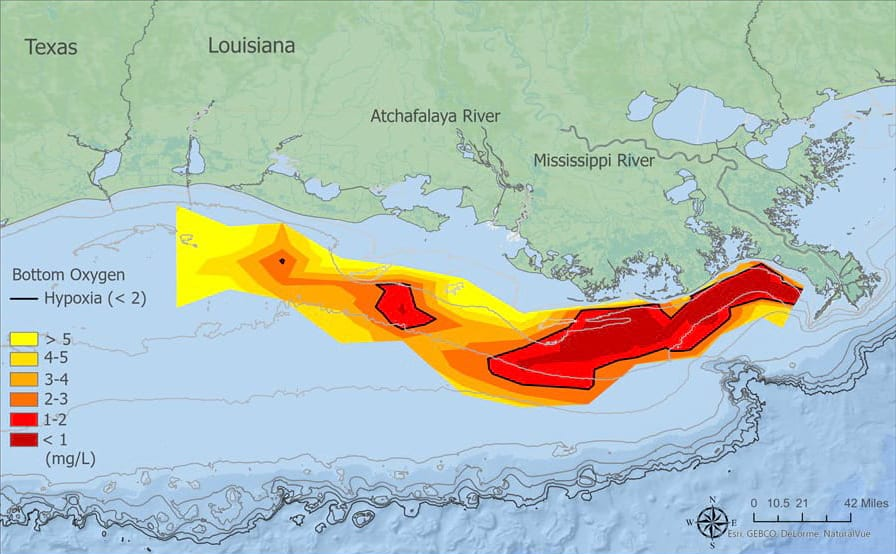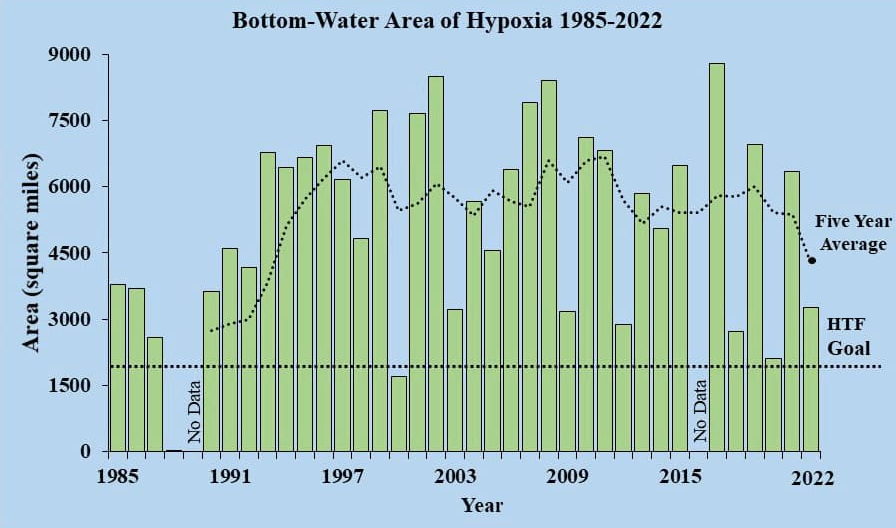This Year’s Gulf Dead Zone Measurement Sparks Disappointment & Optimism – Here’s Why

(Current extent of the 2022 hypoxic zone. Source: NOAA and the Louisiana Universities Marine Consortium)
Spanning 6,334 square miles in 2021, an area larger than the state of Connecticut, is the Gulf of Mexico “dead zone.” This region of hypoxia – or oxygen-depleted water – is the 2nd-largest in the world, resulting in fatal consequences for marine life.
Although the phenomenon of hypoxia can occur naturally, the situation in the Mississippi River watershed is made worse by our actions. Excess fertilizer results in too much nitrogen and phosphorus ending up in our waterways. Compounded over our entire Mississippi River basin, this fertilizer pollution not only creates the massive Gulf of Mexico “dead zone,” but also lake and beach closures in all of our River states.
Five years after the largest Gulf dead zone was recorded in 2017 at 8,776 square miles, the National Oceanic and Atmospheric Association (NOAA) has once again measured the spread of this year’s hypoxic zone. With an assessed size of 3,275 square miles the magnitude of this measurement sparks both disappointment and optimism, and here’s why:
Disappointment. Although fertilizers found in agricultural runoff have become the leading cause of water quality impairments within our rivers and streams, it is not only their use, but also their production that has created cycles of harm. Nitrogen-based fertilizers are created through natural gas extraction from deep sea wells or fracking on land. In addition, many of these deep sea extraction locations are along the Gulf Coast (remember the Deepwater Horizon oil spill?), and the gas is pumped via underwater pipelines to fertilizer plants. Eventually, the manufactured nitrogen fertilizers make their way to fields along the waterways that feed the Mississippi River and drain back into the Gulf, polluting an already vulnerable ecosystem.
This cycle of harm impacts all of us. The dead zone has devastating impacts on food chains and fisheries in the Gulf. What’s more, these fertilizer production facilities located along the River contribute to environmental racism within Louisiana’s Cancer Alley, while producing toxic waste products that end up in our waterways and drinking water. In 2008, the Gulf Hypoxia Task Force set their goal of reducing the hypoxic zone to 1,900 square miles by 2015, but have yet to achieve their goal.
What we need is change through action, and our individual efforts have the power to leverage this change.

(Sediment in the Gulf of Mexico off the Louisiana Coast. Photo via the United States Geological Survey)
Optimism. Despite the challenges presented by the dead zone, this year’s measurement is (luckily) smaller than the year before, and has the potential to be part of a continuous trend in recent years of a decreasing average size over time (see graph below). Although it is too early to tell if this decreasing trend will continue, it is not too late (far from it) for the Gulf, the Mississippi River, or even the Task Force to reach its original 1,900 square mile goal.
Join fellow River Citizens throughout the 10 mainstem Mississippi River states and ask the Gulf Hypoxia Task Force to take a new approach to tackling the Gulf dead zone. As we work towards positive systemic changes through policy initiatives such as the Mississippi River Restoration and Resilience Initiative (MRRRI), we can alleviate this crisis and the burdens of pollution in our communities also through individual responses. Our actions at both levels – systemic and individual – are meaningful and important.
Many of us, human and non-human species, call this watershed home. How we show up for each other in support of the local and regional community is where we leverage our collective strength. Strong communities lead to a stronger river, stronger economy, and a healthier environment for all to grow and thrive.
Join our
COMMUNITY
And Get a Free E-book!
When you sign up as a River Citizen you’ll receive our newsletters and updates, which offer events, activities, and actions you can take to help protect the Mississippi River.
You’ll also get our free e-book, Scenes From Our Mighty Mississippi, an inspiring collection of images featuring the River.
Get to know Lily by reading her bio here.
Step 1
Become a River Citizen
Yes! The River can count on me!
I am committed to protecting the Mississippi River. Please keep me informed about actions I can take to protect the Mississippi River as a River Citizen, and send me my free e-book!, Scenes From Our Mighty Mississippi!
Step 2
LEARN ABOUT THE RIVER
We protect what we know and love. As a River Citizen, you’ll receive our email newsletter and updates, which offer countless ways to engage with and learn more about the River. You can also follow us on Instagram, Facebook, X (Twitter) , and YouTube, where we share about urgent issues facing the River, such as nutrient pollution, the importance of floodplains and wetlands, and bedrock legislation such as Farm Bill Conservation Programs.
Step 3
Take Action
There are many ways you can jump in and take action for a healthy Mississippi River. Our 10 actions list includes simple steps you can take at any time and wherever you are. Check out our action center for current action alerts, bigger projects we are working on, and ways to get involved.


